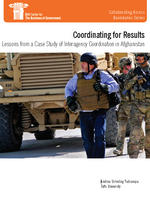
Coordinating for Results: Lessons from a Case Study of Interagency Coordination in Afghanistan

This report focuses on interagency coordination and thus differs from many earlier IBM Center reports that have examined the use of collaboration. Dr. Strimling Yodsampa notes that, when agencies collaborate, they work side by side toward a shared goal. When they coordinate, they still maintain their organizational autonomy and independence of action, but they deliberately align resources, capabilities, strategies, and implementation in support of shared goals.
In developing this report, the author analyzes the interactions between U.S. civilian and military efforts in Afghanistan from 2001-2009. She draws on scores of confidential and candid interviews with key players, including ambassadors and generals, to identify the challenges and successes of coordination between their institutions.
She vividly describes examples of successful coordination on initiatives such as school and road construction and the 2004 Afghan national elections. These examples succeeded when the civilian and military institutions leveraged their joint funding sources and networks to achieve common goals. But she also observed instances where the lack of coordination resulted in the two institutions duplicating each other’s effort, or at worst, inadvertently undermining the other’s activities or goals. Based on her observations, she offers recommendations on how agencies can better assure effective coordination.



